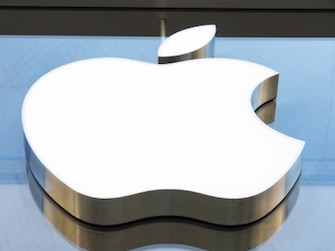 Apple Inc. (NASDAQ:AAPL) of Cupertino, CA, is a developer of consumer electronics, computer software, personal computers and online services and part of the Elite 8 of our Companies We Follow series. The company has been making headlines recently with the release of its new Apple Music online radio platform, which has a database of more than 30 million songs which the company hopes will earn 100 million subscribers who can pay about $10 per month once the service’s free trial ends. Fans of Apple’s iPod personal music player, which has largely fallen by the wayside compared to the iPhone and other Apple products, have perked up after noticing that the latest Apple iTunes update contains graphics of iPod varieties which are not currently available. Despite the strong smartphone sales of Samsung, which we discuss in their recent Companies We Follow profile, Apple has shot to the lead of that tech market with 43.5 percent of U.S. smartphone subscribers.
Apple Inc. (NASDAQ:AAPL) of Cupertino, CA, is a developer of consumer electronics, computer software, personal computers and online services and part of the Elite 8 of our Companies We Follow series. The company has been making headlines recently with the release of its new Apple Music online radio platform, which has a database of more than 30 million songs which the company hopes will earn 100 million subscribers who can pay about $10 per month once the service’s free trial ends. Fans of Apple’s iPod personal music player, which has largely fallen by the wayside compared to the iPhone and other Apple products, have perked up after noticing that the latest Apple iTunes update contains graphics of iPod varieties which are not currently available. Despite the strong smartphone sales of Samsung, which we discuss in their recent Companies We Follow profile, Apple has shot to the lead of that tech market with 43.5 percent of U.S. smartphone subscribers.
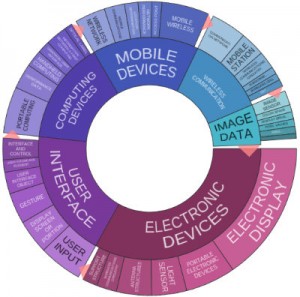 Speaking of Samsung, the two companies have become major competitors in the U.S. patent world and the past few years are rife with court battles between them both. Most recently, the U.S. Court of Appeals for the Federal Circuit upheld an Apple damages award for about $930 million from Samsung for alleged infringement of Apple design patents. In 2014, Apple was 11th among all companies earning patents from the U.S. Patent and Trademark Office with 2,003 patents issued that year. During the second quarter of 2015, Apple earned 500 U.S. patents, according to patent analysis data available from Innography. The text cluster provided shows us that most of Apple’s recent innovation has focused on electronic devices, computing devices and mobile devices.
Speaking of Samsung, the two companies have become major competitors in the U.S. patent world and the past few years are rife with court battles between them both. Most recently, the U.S. Court of Appeals for the Federal Circuit upheld an Apple damages award for about $930 million from Samsung for alleged infringement of Apple design patents. In 2014, Apple was 11th among all companies earning patents from the U.S. Patent and Trademark Office with 2,003 patents issued that year. During the second quarter of 2015, Apple earned 500 U.S. patents, according to patent analysis data available from Innography. The text cluster provided shows us that most of Apple’s recent innovation has focused on electronic devices, computing devices and mobile devices.
The economic picture for Apple has been pretty rosy in recent months and the investment bank UBS has maintained a “buy” status on Apple stock as recently as July 2nd. At least some part of the company’s profits stem from a savvy knowledge of tax code around the world; it was recently pointed out that Apple paid £12 million in corporate taxes to Britain but the total would have been closer to £400 million without taking advantage of tax loopholes in Ireland. Apple’s 2015 third quarter earning results will be released on July 21st, giving the world its latest look into sales of the iPhone 6 and iPhone 6 Plus and perhaps the first official reports regarding sales of the Apple Watch, which was just released in the previous quarter.
[Companies-1]
Patent Applications of Note: From Secure Digital Payments to Digital Music Systems
A couple of the patent applications published in recent months by Apple outline some novel systems developed by Apple which make it easier to shop with the use of an electronic device. The Apple Pay mobile payment service created by the company should get an important security upgrade through the technology described within U.S. Patent Application No. 20150127549, which is titled Using Biometric Authentication for NFC-Based Payments. The electronic device claimed here includes a secure element with a payment applet and a processor which is configured to compare local authentication information for the device with stored authentication information. The processor also provides local validation information for the device to allow a payment applet to conduct a financial 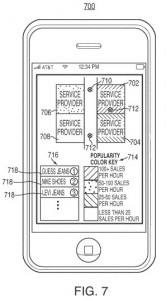 transaction. This system relates to secure mobile payments and works without requiring a user to manually input authentication information for each transaction. An interesting shopping assistant designed for use in brick-and-mortar retail establishments would be protected by U.S. Patent Application No. 20150142569, titled Systems and Methods for Accessing Shopping Center Services Using a Portable Electronic Device. This patent application discloses a method of connecting a portable electronic device to a shopping center server, receiving product sales information associated with products available at a shopping center, detecting the user’s preference for a product, receiving a time-sensitive personalized promotion for the product to be redeemed at the shopping center and displaying that promotion and its expiration time on the device. This system aims to provide consumers with accurate data on the popularity of certain items and even provide a “heat map” of a store which indicates the location of popular items.
transaction. This system relates to secure mobile payments and works without requiring a user to manually input authentication information for each transaction. An interesting shopping assistant designed for use in brick-and-mortar retail establishments would be protected by U.S. Patent Application No. 20150142569, titled Systems and Methods for Accessing Shopping Center Services Using a Portable Electronic Device. This patent application discloses a method of connecting a portable electronic device to a shopping center server, receiving product sales information associated with products available at a shopping center, detecting the user’s preference for a product, receiving a time-sensitive personalized promotion for the product to be redeemed at the shopping center and displaying that promotion and its expiration time on the device. This system aims to provide consumers with accurate data on the popularity of certain items and even provide a “heat map” of a store which indicates the location of popular items.
Device accessories are still a focus of some research and development over at Apple as can be seen within U.S. Patent Application No. 20150163582, entitled Seamless Earbud Structures and Methods for Making the Same. The earbud that would be protected has a housing with a first sub-enclosure coupled to a second sub-enclosure to define an interior housing volume, a driver assembly within the interior volume of the housing and a seamless coating provided on the portion of the housing forming the junction between the two sub-enclosures. The two sub-enclosures of this invention allows Apple to create a tightly fitting junction between them both, allowing for the application of a uniform coating of smooth material on the earbud.
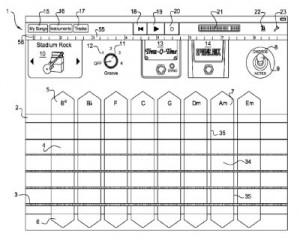 Technology developers like Apple always seem to be involved in an incredibly diverse aspects of consumer lifestyles. An intriguing digital music recording system meant to cater to both experienced musicians as well as beginners is the subject of U.S. Patent Application 20150114209, entitled Musical Systems and Methods. This would protect a method of displaying a virtual musical instrument (VMI) on a touch-sensitive graphical user interface (GUI); the VMI has a number of adjacent swipe regions associated with assigned chords as well as virtual strings crossing the swipe region associated with a note of the assigned chord. This system is designed to strike a balance between the experience of playing a real musical instrument while enabling easier playing functions for those without a great deal of music theory knowledge. The dynamic creation of social groups based on the daily lifestyle of a device user is discussed within U.S. Patent Application No. 20150127728, entitled Lifestyle-Based Social Groups. The method that would be protected by this patent application involves receiving significant location and activity information regarding locations where device users remain past a threshold time amount and significant activities performed in that location. The method also determines a social group based on the location and a theme based on the activity and provides a recommendation to a user to join the social group. This invention is designed to enable the formation of ad-hoc social networks among device owners with similar interests and areas of residence.
Technology developers like Apple always seem to be involved in an incredibly diverse aspects of consumer lifestyles. An intriguing digital music recording system meant to cater to both experienced musicians as well as beginners is the subject of U.S. Patent Application 20150114209, entitled Musical Systems and Methods. This would protect a method of displaying a virtual musical instrument (VMI) on a touch-sensitive graphical user interface (GUI); the VMI has a number of adjacent swipe regions associated with assigned chords as well as virtual strings crossing the swipe region associated with a note of the assigned chord. This system is designed to strike a balance between the experience of playing a real musical instrument while enabling easier playing functions for those without a great deal of music theory knowledge. The dynamic creation of social groups based on the daily lifestyle of a device user is discussed within U.S. Patent Application No. 20150127728, entitled Lifestyle-Based Social Groups. The method that would be protected by this patent application involves receiving significant location and activity information regarding locations where device users remain past a threshold time amount and significant activities performed in that location. The method also determines a social group based on the location and a theme based on the activity and provides a recommendation to a user to join the social group. This invention is designed to enable the formation of ad-hoc social networks among device owners with similar interests and areas of residence.
Interesting, the vehicle location technology discussed in the previous section was not the only automotive technology from Apple that we came across in our most recent survey of the company’s R&D. U.S. Patent Application No. 20150147974, which is titled Accessing a Vehicle Using Portable Devices, would protect a method of accessing a secured object by establishing a connection between a first portable device and the secured object, receiving an access credential for the secured object through the connection, establishing a second connection between the first portable device and a second device and transmitting the access credential across the second connection between the first and second portable devices. This system, which again relies on Bluetooth low-energy digital wireless communications, enables access to a vehicle in such a way that prevents the engine from operating if a device with access credentials is not within proximity of the vehicle.
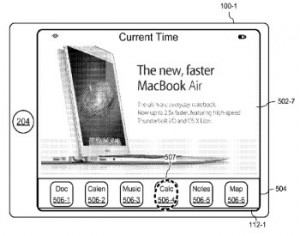 Finally, we’ll wrap up our survey of Apple’s most recent intellectual property filings with a look at one technology designed to address shortcomings in interacting with multiple applications at the same time running on a single device. U.S. Patent Application No. 20150169182, titled Device, Method, and Graphical User Interface for Managing and Interacting with Concurrently Open Software Applications, would protect an electronic device which displays a first application view corresponding to a first application; the device has a second view mode which displays a group of application icons adjacent to the first application view for allowing interactions with a second application. This innovation was designed to address shortcomings with conventional systems of managing multiple running applications, which can require extra time in switching between applications and waste too much battery power.
Finally, we’ll wrap up our survey of Apple’s most recent intellectual property filings with a look at one technology designed to address shortcomings in interacting with multiple applications at the same time running on a single device. U.S. Patent Application No. 20150169182, titled Device, Method, and Graphical User Interface for Managing and Interacting with Concurrently Open Software Applications, would protect an electronic device which displays a first application view corresponding to a first application; the device has a second view mode which displays a group of application icons adjacent to the first application view for allowing interactions with a second application. This innovation was designed to address shortcomings with conventional systems of managing multiple running applications, which can require extra time in switching between applications and waste too much battery power.

![[IPWatchdog Logo]](https://ipwatchdog.com/wp-content/themes/IPWatchdog%20-%202023/assets/images/temp/logo-small@2x.png)

![[Advertisement]](https://ipwatchdog.com/wp-content/uploads/2024/04/Patent-Litigation-Masters-2024-sidebar-700x500-1.jpg)

![[Advertisement]](https://ipwatchdog.com/wp-content/uploads/2021/12/WEBINAR-336-x-280-px.png)
![[Advertisement]](https://ipwatchdog.com/wp-content/uploads/2021/12/2021-Patent-Practice-on-Demand-recorded-Feb-2021-336-x-280.jpg)
![[Advertisement]](https://ipwatchdog.com/wp-content/uploads/2021/12/Ad-4-The-Invent-Patent-System™.png)






Join the Discussion
2 comments so far.
txp
October 21, 2015 05:51 pmPerhaps you are right, however I don’t agree and I have put my money on it. I am in a position where I have a NZ patent pending on a mobile payment system via a communication network with a live filing date of 2004, and I am now in the process of taking it to grant. You ask how that can be? well up to recently New Zealand patent law allowed divisionals to be filed. The law changed in 2013, however my application is exempt from those changes. I am now working on competitor focused claims to complete the application, and thus have a patent with a filing date of 2004. I will be looking to licence it to those mobile payment systems that may well find that they will be infringing. The law is the law and it doesn’t matter necessarily what size you are, and in this case little may well be best.
SoftwareForTheWin
July 8, 2015 01:46 pmFunny how Apple or Google or Samsung or Cisco get all the press for their security innovations – while most of their existing security innovations were from acquisitions.
Unfortunately, today’s small startups are no longer incentivized to pursue patents – for good reason – they’re beyond expensive since 1 patent doesn’t cut it anymore, you need 3 or 4 or 5 minimum and then 7+ years to get them to issue and then $millions to enforce them when large corporation doesn’t return the phone call about potential licensing. Impossible.
No, the individual or small startup is best off to forgo pursuit of patents and instead just implement the software and take customers $revenues. Far easier to compete with a large tech competitor than go down the uncertain, risky, uncompromisingly expensive, dark and gloomy road of patents.